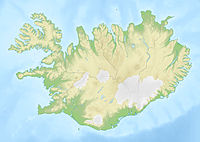- Esjan
-
Esja 
The mountain range EsjaElevation 914 m (2,999 ft) Location 10 km north of Reykjavík,  Iceland
IcelandCoordinates 64°15′N 21°38′W / 64.25°N 21.633°WCoordinates: 64°15′N 21°38′W / 64.25°N 21.633°W Climbing Easiest route hiking The mountain Esja (914 m (2,999 ft)) often called Esjan ("the Esja") is situated in the south-west of Iceland, about 10 km to the north of Iceland's capital city Reykjavík. Esja is not a single mountain, but a volcanic mountain range, made from basalt and tuff-stone.
Formation
Esja was built up at the end of the Pleistocene with the beginning of the Ice Age. During the warm periods, lava flowed and in the cold periods tuff-stone ridges were built under the glacier. The western part of the mountain range is the oldest (about 3.2 million years) and the eastern part is the youngest (about 1.8 million years). The movements of the plate boundaries cutting diagonally through Iceland are pushing the stratums to the west and away from the active volcanic zone. Intrusions, i.e. big magma channels coming from the old central volcanoes at Kjalarnes and Stardal, introduced themselves into the stratums. Big lava fields were the result, one above the other, which the Ice Age glacier ground down. It left only the highest summits like the mountain range of Esja or Akrafjall.
Physical features
The easternmost summits of the mountain range, called Móskarðshnúkar, are of an unusually light colour. An Icelandic writer in the 19th century, so goes the story, hoped to see the sun there after a long period of rain. But when he looked closer, it was only the mountain tops with their colours. In reality, it is the rhyolite stone, often to be found in Icelandic nature near old (and also active) central volcanoes.
Hiking and climbing
Within easy reach of the capital, Esja is a very popular recreation area for hikers and climbers. The best known hiking paths lead to the summits Þverfellshorn (780 m) and Kerhólakambur (851 m). Þverfellshorn is also easily accessible by public transport.
The path is divided into sections, marked with signs along the way. Each sign gives an indication of the difficulty of the path ahead with a grade system ranging from 1 boot (easy) to 3 boots (challenging). At sign 3 experienced climbers can choose to climb directly to the top, instead of following the path which goes off to the right. Approximately 200 meters below the top, there is a point marked with a big rock called Steinn. It is here that most inexperienced climbers choose to go down again, as the path becomes increasingly difficult from there.
The highest point is called, "Habunga" (914 m.). From Þverfellshorn, it is another three kilometer trek north-east, across a rocky plateau with no directional signs or clear path. As of August 2011, Habunga was marked only by a large rock mound with a wooden stick at the top.
Esja can be used as a first name in Iceland. The etymology of the name is unclear. In the Kjalnesingasaga, among Irish settlers there is a rich widow called Esja but probably, aitiologically, the women's name is derived from the mountain and not vice-versa.
Categories:- Mountains of Iceland
- Volcanoes of Iceland
- Pliocene volcanoes
- Pleistocene volcanoes
- Iceland West Volcanic Zone
Wikimedia Foundation. 2010.



